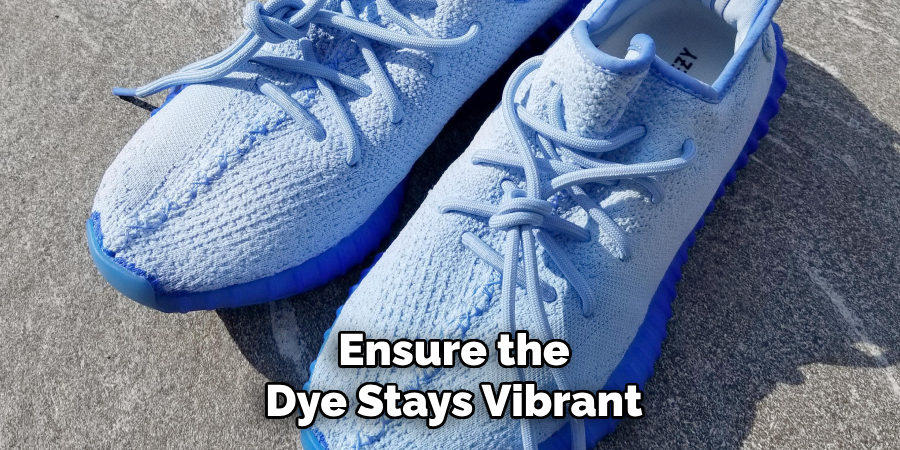Dyeing white shoes is a fun and creative way to personalize your footwear and give them a fresh new look. Whether you’re looking to add a splash of color, match a specific outfit, or simply revamp an old pair of shoes, this process can be both rewarding and straightforward. With the right materials and a bit of patience, you can transform plain white shoes into a unique expression of your style.

This guide on how to dye white shoes will walk you through the steps to ensure successful and vibrant results.
Why Dye White Shoes?
There are many reasons why someone may choose to dye their white shoes. Here are a few potential benefits:
Personalization
By dyeing your white shoes, you can create a one-of-a-kind pair that reflects your personality and style. This is especially useful if you have a specific color or design in mind that you can’t find in stores.
Cost-saving
Dyeing your white shoes can be a cost-effective way to update your footwear without having to purchase new ones. It’s a great option for sprucing up old or worn-out shoes and extending their lifespan.
Environmental impact
By repurposing and recycling old white shoes, you’re reducing the amount of waste that ends up in landfills. Dyeing is also more eco-friendly than buying new shoes as it reduces the need for production and transportation, which contribute to carbon emissions.
7 Simple Step-by-step Guidelines on How to Dye White Shoes
Step 1: Gather Materials
To successfully dye white shoes, you’ll need the following materials:
- Fabric Dye of Your Choice (Liquid or Powder)
- Hot Water
- Large Pot or Bucket
- White Vinegar
- Rubber Gloves
- Old Towel or Cloth to Protect Work Surface
- Optional: Salt for Cotton and Linen Materials, and Rubber Bands for Creating Patterns.
Step 2: Choose the Right Shoes

The first step in dyeing white shoes is selecting the appropriate pair. Ideally, choose shoes made from materials that absorb dye well, such as canvas or fabric. Leather and synthetic materials can be more challenging to dye and may require specialized dyes or techniques.
Ensure that the shoes are clean and free from stains, as dirt or discoloration can affect the final color outcome. Start with a pair of plain white shoes to ensure the dye colors appear vibrant and true to your vision.
Step 3: Prepare Dye Bath
Before you begin the dyeing process, prepare your dye bath by following the instructions on your fabric dye’s packaging. Fill a large pot or bucket with hot water, ensuring there is enough water to fully immerse the shoes. Add the fabric dye to the water, carefully measuring the quantity based on the desired intensity of color.
For deeper, more saturated hues, you can use a slightly higher concentration of dye. Stir the dye solution thoroughly to ensure it is evenly mixed. If dyeing cotton or linen materials, add a tablespoon of salt to the mixture to help set the dye. You may also add a small amount of white vinegar to aid in bonding the dye to fabric surfaces. Once prepared, your dye bath is ready for use.
Step 4: Protect Work Surface

Before starting the dyeing process, take precautions to protect your work surface from spills or stains. Lay down an old towel, cloth, or plastic sheet over the area where you’ll be working. This will help catch any drips or splashes that may occur during the dyeing process.
Additionally, wearing rubber gloves will protect your hands from dye stains, and keeping paper towels or a damp cloth nearby can allow you to quickly clean up any accidental spills. Ensuring your workspace is properly protected will make the process easier and prevent unwanted messes.
Step 5: Wear Protective Gear
Safety and cleanliness are key when dyeing your white shoes, so it’s crucial to wear protective gear. Start by putting on a pair of rubber gloves to protect your hands from coming into direct contact with the dye, which can stain your skin.
Consider wearing an old apron or clothes you don’t mind getting stained, as dye can be difficult to remove from fabrics. If you’re working in an enclosed area, it’s a good idea to use a mask or ensure the space is well-ventilated, especially if the dye emits strong odors. Proper protective gear will help you avoid messes and stay safe throughout the process.
Step 6: Dye the Shoes
Once your dye bath is prepared and your workspace is protected, it’s time to start dyeing the shoes. Submerge the shoes completely into the dye bath, ensuring that every part of the fabric is immersed for an even application. Use tongs or a stirring stick to gently move the shoes around in the solution, allowing the dye to penetrate thoroughly.
The amount of time the shoes should remain in the dye bath will depend on the material and the desired depth of color. Check the fabric dye’s instructions for guidance, but as a general rule, keep them submerged for at least 10-30 minutes, checking periodically to see how the color develops.
If you’re looking to create a pattern or ombre effect, you can use rubber bands or submerge only parts of the shoes to achieve your desired design. Be sure to follow the instructions on your fabric dye’s packaging for any specific techniques.
Step 7: Rinse and Dry
Once the desired color is achieved, remove the shoes from the dye bath and rinse them under cool running water until the water runs clear. You may also opt to let them soak in a mixture of warm water and white vinegar for about 10 minutes before rinsing. This will help set the color and prevent any remaining excess dye from transferring onto other surfaces.

After rinsing, gently squeeze out excess water and leave the shoes to air dry completely before wearing them. Avoid using heat sources or direct sunlight, as this can cause uneven dyeing or fading. Once dry, you’ll have a unique pair of dyed white shoes ready to show off!
Following these simple steps on how to dye white shoes will allow you to easily and creatively transform your old white shoes into a stylish and eco-friendly new pair. So, next time you’re considering tossing out those worn-out white shoes, why not give them a new life with a fresh coat of dye? Happy dyeing!
Frequently Asked Questions
Q1: Do I Need to Use Special Fabric Dye for Shoes, or Can I Use Regular Fabric Dye?
A1: It’s best to use a fabric dye specifically made for shoes, as these tend to have better color fastness and are designed to be used on various materials. However, you can also use regular fabric dye if that is all you have available, but the results may vary.
Q2: Can I Use Natural Dyes to Color My White Shoes?
A2: Yes, natural dyes such as turmeric or beetroot can be used to color white shoes. However, keep in mind that these dyes may not produce intense or long-lasting colors compared to synthetic dyes. It’s best to do a patch test first before fully dyeing your shoes with natural dyes.
Q3: How Do I Prevent the Dye from Fading While Wearing the Shoes?
A3: To ensure the dye stays vibrant and doesn’t fade while wearing the shoes, it’s essential to properly set the dye. This can be done by following the instructions on your fabric dye’s packaging, usually involving soaking the dyed shoes in a mixture of water and white vinegar for 30 minutes before rinsing. Additionally, avoid exposing the dyed shoes to direct sunlight or harsh chemicals that may cause fading.

Q4: Can I Dye Colored Shoes with White Fabric Dye?
A4: Yes, you can dye colored shoes with white fabric dye to achieve a lighter or pastel color. However, keep in mind that the original color of the shoes will affect the outcome of the dye. For example, if you try to dye red shoes with white fabric dye, you may end up with pink shoes instead of white. It’s best to do a patch test first before fully dyeing your colored shoes with white fabric dye.
Conclusion
Revamping your old white shoes with dye is an excellent way to add a personal touch and breathe new life into your footwear. Not only is this process cost-effective and environmentally friendly, but it also allows for endless creativity, ensuring that your shoes are truly one of a kind. By following the simple, step-by-step guidelines on how to dye white shoes outlined above, you can achieve vibrant, professional-looking results with minimal effort.
Whether you’re experimenting with bold colors or subtle patterns, dyeing offers a rewarding opportunity to express your style in a sustainable way. Give it a try and take pride in your unique, custom-designed shoes!

